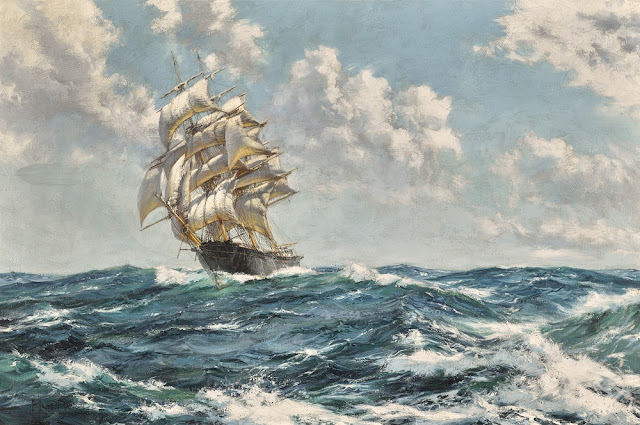Johannes Hermanus Koekkoek, 1778 - 1851, DUTCH
A MERCHANTMAN OFF VEERE
Oil on canvas
164.5 by 84cm., 64½ by 33in.
Private Collection
Veere is a municipality in the southwestern Netherlands, in the region of Walcheren in the province of Zeeland.
Wolfert Van Borssele established a ferry and ferry house there in 1281. In the same year Wolfert also built the castle Sandenburg on one of the dikes he had built. On 12 November 1282, Count Floris V. thereupon issued a charter by which Wolfert received the sovereignty to the land and castle with the ferry and ferry house. Veere was a prosperous trading city, with about 750 houses inside the city walls. More on Veere
Johannes Hermanus Koekkoek, (Veere, 17
August 1778 – Amsterdam, 9 January 1851) was a Dutch painter and draughtsman. He was the head of an artistic family. His
sons were all successful artists; the first two specialized in marine art, and
Marinus was primarily a landscape painter. His grandson Johannes Hermanus
Barend Koekkoek also became an artist.
ohannes Hermanus Koekkoek initially trained under
Thomas Gaal, working in a wallpaper factory. He became primarily a marine art
and genre art painter. He was active between 1793 and 1851, and worked in
Middelburg, Durgerdam, Amsterdam (1833–1851), and Medemblik (1838) and Katwijk
aan Zee. More Johannes Hermanus Koekkoek
Please visit my other blogs: Art
Collector, Mythology, Marine
Art, Portrait of a Lady, The
Orientalist, Art of the Nude and The Canals of
Venice, And visit my Boards on Pinterest
Images are copyright of their
respective owners, assignees or others. Some Images may be subject to copyright
I don't own any of these images -
credit is always given when due unless it is unknown to me. if I post your
images without your permission, please tell me.
I do not sell art, art prints, framed
posters or reproductions. Ads are shown only to compensate the hosting
expenses.
If you enjoyed this post, please share
with friends and family.
Thank you for visiting my blog and also
for liking its posts and pages.















